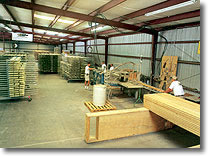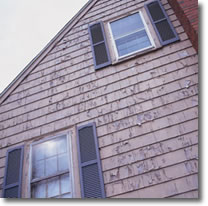The CMF Process
Carolina Machine Finishing is a process that ensures a longer-lasting and higher quality paint/stain job than traditional "on-site" applications. All six sides of a board are coated and proper spread rates are maintained for maximum coverage and protection under the factory-controlled environment by Carolina Machine Finishing.

Benefits of Carolina Machine Finishing
- Precoated materials are protected from damage by weather
- Saves time and reduces labor costs
- Reduces costly scheduling, weather or seasonal delays
- Virtually eliminates over spray, dripping, splattering or clean-up problems
- The job site is neat and the project looks finished immediately
- No color variation, lap marks, shrink lines, streaking or dirt pick-up
The Problem - The number one cause of most exterior siding and trim paint failure lies simply in moisture infiltration. The majority of this moisture originates from the heat transfer that occurs between the inside (cooled) air of a house and the (heated) exterior air. Typically in the South, the air inside a home is cooled up to three-fourths of the year while the exterior is heated as it is battered by the sun. As the sun's rays heat the exterior siding of a home, humidity begins to collect in the form of condensation in the cooler airspace directly behind the heated siding. This process is similar to setting a cold glass of lemonade on a picnic table during a hot summer day... condensation begins to form on the glass surface due to the presence of humidity because of the temperature inversion between the cool surface of the glass and the hot surrounding air. This same phenomenon occurs in a home when the exterior surface is heated and the air directly behind the siding is significantly cooler. The airborne humidity collects on the homes vapor barrier (felt paper or TYVEK) in the form of condensation. The heavy moisture droplets drain down the wall and run out over the flashing. However, the smaller moisture/condensation droplets are drawn directly toward the heat source (the sun), by evaporation, and enter the back side of the uncoated siding or trim. This moisture continues to be pulled through the siding via evaporation until it reaches the painted exterior surface. With nowhere to go, the moisture continues to build pressure behind the paint until eventually the pressure of the moisture trying to escape exceeds the ability of the coating to adhere, and the paint begins to let go and peel off.

Once the peeling process begins there is no permanent solution without siding replacement.
The Solution - Carolina Machine Finishing minimizes this moisture infiltration problem through a factory-controlled encapsulation process whereby all six sides of a board are uniformly coated with a primer or other top quality coating. This process occurs in a horizontal plane, allowing for the application of two to three times the thickness of a field-applied coating which is applied in the vertical plane and is therefore limited in thickness due to gravity. All CMF coated products are then air dried on special racks where they await additional coats of finish or packaging for shipment.
For builders using the CMF process, pre-finished materials reach the job site protected from the elements. The prepriming process reduces weather delays and other problems such as over-spray or splatter that occur during a typical exterior paint process. For the homeowner, pre-priming/pre-finishing encapsulates and protects their investment and provides a low-maintenance alternative to less desirable sidings.
All CMF coatings are applied under factory-controlled conditions where the most stringent quality control procedures are followed. All six sides of the board, including the butt-ends, are completely encapsulated ensuring ultimate protection from nature's elements. These coatings are mechanically brushed deep into the surface of the siding or trim for maximum penetration and then racked and dried thoroughly prior to leaving the factory - stabilizing the siding and preventing possible shrinkage. The finished siding arrives at the construction site protected from exposure to moisture and sunlight.
Carolina Machine Finishing, Inc.
Address: 4696 Franchise St.
North Charleston, SC 29418
Phone: 843-760-0029
Fax: 843-760-0266

